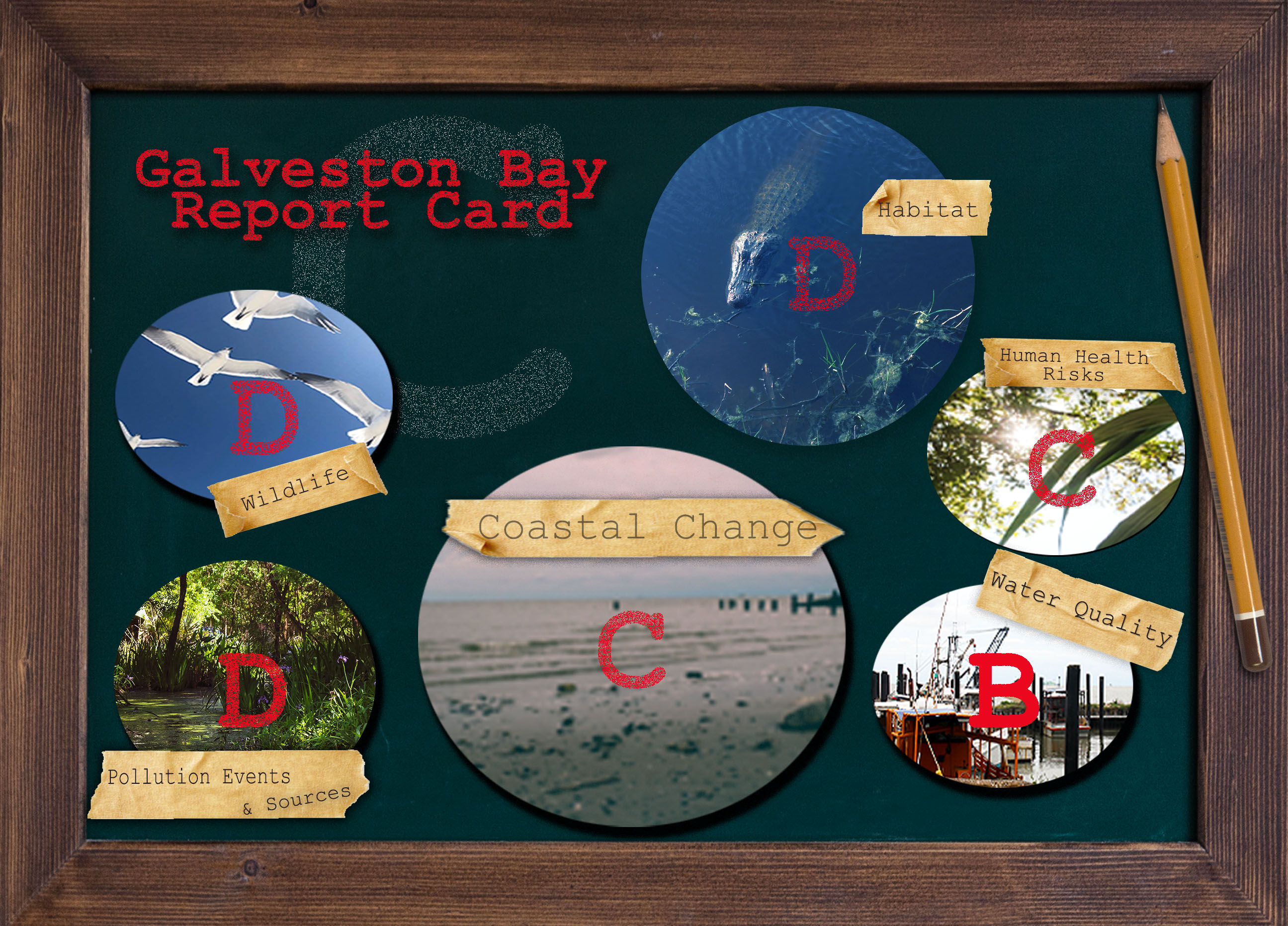
Galveston Bay Foundation report card shows improvement and setbacks

The health of Galveston Bay is “adequate for now” based on the assessment made by the Galveston Bay Foundation and the Houston Advanced Research Center (HARC) in their 2019 Galveston Bay report card. Since 2015, the Galveston Bay Foundation and HARC have monitored the health of the Bay using data from state and federal agencies. Each year the bay has received an overall grade of a C.
All data used to complete the report card was acquired from Texas Parks and Wildlife, the EPA Gulf of Mexico, and the National Oceanic and Atmospheric Administration. The project is supported by the Houston Endowment and citizen volunteers across Houston and the State of Texas.
Once collected, all of the data is then analyzed by scientists at HARC. Specific species, wetlands and the entire Bay area were then given a science-based grade describing their health. Grades range from A, “excellent health,” to F, “requires action.”
T’Noya Thompson, advocacy programs manager for the Galveston Bay Foundation, and Erin Kenny, a research scientist at HARC, see the report as “easy to digest” and gives the public a better idea on the health of the Bay and bayous. While the Bay was given an overall grade of C or “adequate for now,” specific aspects of the Bay saw signs of improvement while others had a decline in 2019.
Thompson and Kenny both saw the improvement of wildlife as a highlight of the 2019 report. Wildlife earned the grade of F in 2018 and increased to a D in 2019. Among wildlife, the blue crab population showed signs of sustaining in the 2019 report, contrary to past reports showing their decline in numbers.
“Blue crabs are very important for our food web,” Thompson said. “At all stages of their life, blue crabs are food for coastal fish and birds. They are also filter feeders, playing a vital role in balancing water quality.”
Kenny describes the blue crabs as “the canary of the sea.”
“The success of the species will help other species sustain,” Kenny said.
Declining from an A to a B, water quality was an area of concern for both Thompson and Kenny. Increased levels in phosphorus have led to algae blooms and low levels of oxygen in the water causing large die-offs among fish populations in the bay and waterways that feed into it.
George Guillen, executive director of the Environmental Institute of Houston and professor of biology and environmental science at the University of Houston-Clear Lake, explained this as an issue of the dense populations that have settled along the Bay and bayous.
“The oils and chemicals from cars and cleaning materials we use in our houses always find their way into waterways and have a drastic adverse impact on water quality,” Guillen said.
Within the category of coastal change, the report made clear with the grade of F that the Gulf Coast is changing, mostly because of rain-driven flooding that has become more routine in recent years.
“Replacing coastal prairies and wetlands with impermeable concrete not only destroys habitats but increases the frequency of flooding events,” Guillen said.
More powerful storms caused by climate change, coupled with an infrastructure that cannot support such rain, leads to more intense erosion along bayous altering the landscape. Kenny expressed that for the Bay and bayous to stay healthy, wetlands must be protected. Looking forward to the 2020 report and the future health of Galveston Bay, Kenny explained the biggest threat to the health of the Bay is the disappearing wetlands.
“Wetlands play an important role in the health of the Bay; without them, there is no habitat for animals,” Kenny said.
The report primarily focuses on the resiliency of the areas studied, that is “not their resistance to change, but their ability to bounce back after an event,” Kenny said.
After the events of Hurricane Harvey and an average of 230 oil spills each year, the Bay has “remained resilient.” One factor that adds to Galveston Bay’s ability to bounce back from such events is the abundance of wetlands and estuaries.
“When one part of the Bay’s wetlands are affected by an event, another is able to pick up the slack in keeping the Bay healthy,” Kenny said.
Kenny, Thompson and Guillen all expressed the importance of people getting involved and active in “creating a healthier bay.”
“The Galveston Bay Foundation is an open organization [that welcomes] volunteers and those looking for career opportunities,” Thompson said.
Established in 1987, the Galveston Bay Foundation is a non-profit that does work in advocacy, education and conservation regarding Galveston Bay and the rivers and bayous that feed into it. Galveston Bay’s report card project of assessing the health of Galveston Bay began when HARC asked the citizens what they would want to know about the Bay and the wetlands and estuaries around Southeast Texas.
After the public responded with an interest in learning about the Bay’s health, a partnership with the Galveston Bay Foundation was created to help release the data to the public.
The Galveston Bay Foundation also hosts many events focused on preserving the Bay. From cleaning up beaches to trash pickups and crab trap removals, there are many ways for people to get involved with the organization.
HARC also conducts many research projects regarding the health of Galveston Bay and other areas within the Houston area. Located on the campus of the University of Houston-Clear Lake, the Environmental Institute of Houston also welcomes volunteers for their various coastal and prairie restoration projects.
For more information on the Galveston Bay report card, go to galvbaygrade.org. Find more information about volunteering with the Galveston Bay Foundation or the Environmental Institute of Houston at www.galvbay.organd www.uhcl.edu/environmental-institute/.
HARC also has more information on the quality of Galveston Bay, air quality of the Houston area and clean energy, on its website www.harcresearch.org.
